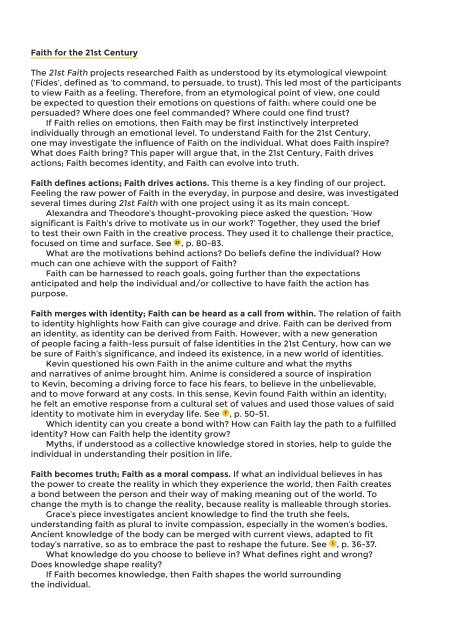21st Faith
We are a collaborative research project, investigating and questioning faith as a human feeling. This publication presents 32 creative projects created for an exhibition in October 2017 at The Workshop, Lambeth.
We are a collaborative research project, investigating and questioning faith as a human feeling.
This publication presents 32 creative projects created for an exhibition in October 2017 at The Workshop, Lambeth.
You also want an ePaper? Increase the reach of your titles
YUMPU automatically turns print PDFs into web optimized ePapers that Google loves.
<strong>Faith</strong> for the <strong>21st</strong> Century<br />
The <strong>21st</strong> <strong>Faith</strong> projects researched <strong>Faith</strong> as understood by its etymological viewpoint<br />
(‘Fides’, defined as ‘to command, to persuade, to trust). This led most of the participants<br />
to view <strong>Faith</strong> as a feeling. Therefore, from an etymological point of view, one could<br />
be expected to question their emotions on questions of faith: where could one be<br />
persuaded? Where does one feel commanded? Where could one find trust?<br />
If <strong>Faith</strong> relies on emotions, then <strong>Faith</strong> may be first instinctively interpreted<br />
individually through an emotional level. To understand <strong>Faith</strong> for the <strong>21st</strong> Century,<br />
one may investigate the influence of <strong>Faith</strong> on the individual. What does <strong>Faith</strong> inspire?<br />
What does <strong>Faith</strong> bring? This paper will argue that, in the <strong>21st</strong> Century, <strong>Faith</strong> drives<br />
actions; <strong>Faith</strong> becomes identity, and <strong>Faith</strong> can evolve into truth.<br />
<strong>Faith</strong> defines actions; <strong>Faith</strong> drives actions. This theme is a key finding of our project.<br />
Feeling the raw power of <strong>Faith</strong> in the everyday, in purpose and desire, was investigated<br />
several times during <strong>21st</strong> <strong>Faith</strong> with one project using it as its main concept.<br />
Alexandra and Theodore’s thought-provoking piece asked the question: ‘How<br />
significant is <strong>Faith</strong>’s drive to motivate us in our work?’ Together, they used the brief<br />
to test their own <strong>Faith</strong> in the creative process. They used it to challenge their practice,<br />
focused on time and surface. See 21 , p. 80-83.<br />
What are the motivations behind actions? Do beliefs define the individual? How<br />
much can one achieve with the support of <strong>Faith</strong>?<br />
<strong>Faith</strong> can be harnessed to reach goals, going further than the expectations<br />
anticipated and help the individual and/or collective to have faith the action has<br />
purpose.<br />
<strong>Faith</strong> merges with identity; <strong>Faith</strong> can be heard as a call from within. The relation of faith<br />
to identity highlights how <strong>Faith</strong> can give courage and drive. <strong>Faith</strong> can be derived from<br />
an identity, as identity can be derived from <strong>Faith</strong>. However, with a new generation<br />
of people facing a faith-less pursuit of false identities in the <strong>21st</strong> Century, how can we<br />
be sure of <strong>Faith</strong>’s significance, and indeed its existence, in a new world of identities.<br />
Kevin questioned his own <strong>Faith</strong> in the anime culture and what the myths<br />
and narratives of anime brought him. Anime is considered a source of inspiration<br />
to Kevin, becoming a driving force to face his fears, to believe in the unbelievable,<br />
and to move forward at any costs. In this sense, Kevin found <strong>Faith</strong> within an identity;<br />
he felt an emotive response from a cultural set of values and used those values of said<br />
identity to motivate him in everyday life. See 7 , p. 50-51.<br />
Which identity can you create a bond with? How can <strong>Faith</strong> lay the path to a fulfilled<br />
identity? How can <strong>Faith</strong> help the identity grow?<br />
Myths, if understood as a collective knowledge stored in stories, help to guide the<br />
individual in understanding their position in life.<br />
<strong>Faith</strong> becomes truth; <strong>Faith</strong> as a moral compass. If what an individual believes in has<br />
the power to create the reality in which they experience the world, then <strong>Faith</strong> creates<br />
a bond between the person and their way of making meaning out of the world. To<br />
change the myth is to change the reality, because reality is malleable through stories.<br />
Grace’s piece investigates ancient knowledge to find the truth she feels,<br />
understanding faith as plural to invite compassion, especially in the women’s bodies.<br />
Ancient knowledge of the body can be merged with current views, adapted to fit<br />
today’s narrative, so as to embrace the past to reshape the future. See 1 , p. 36-37.<br />
What knowledge do you choose to believe in? What defines right and wrong?<br />
Does knowledge shape reality?<br />
If <strong>Faith</strong> becomes knowledge, then <strong>Faith</strong> shapes the world surrounding<br />
the individual.


